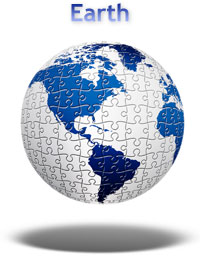GFDL Model Development
Scientists at the Geophysical Fluid Dynamics Laboratory develop and use dynamical, numerical models and computer simulations to improve our understanding and make projections of the behavior of the atmosphere, the oceans, and climate, using state-of-the-art supercomputer and data storage resources. These models have become key tools to understand the physical and biogeochemical processes and the interactions amongst them that control the earth's climate.
Models are used to investigate the extent to which observed climate changes may be due to natural causes (e.g., Sun, volcanic activity) or may be attributable to human activities (e.g., emissions of greenhouse gases and particulates, and land-use). They support more accurate prediction of phenomena in the atmosphere and oceans and on land over seasonal, decadal and centennial time scales. Examples include hurricane research and prediction, seasonal forecasting, and projections of ozone depletion, drought, precipitation, sea-level rise, El Niño-La Niña cycles, global ocean circulation, and chemical transport in the atmosphere (affecting both climate and air quality).
GFDL has had a central role in each assessment of the Intergovernmental Panel on Climate Change (IPCC) since 1990, when their first report was issued. For the most recent assessment issued in 2007, GFDL contributed two of the models used for climate assessments (CM2.0 and CM2.1) and devoted the equivalent of half a year of supercomputing time to produce climate simulations for the IPCC. These models have been successful in representing the observed evolution of 20th century climate from continental-to-global scales, including the dynamics of El Niño and drying in the African Sahel, and providing good seasonal predictive skill. In addition, 13 GFDL scientists contributed to the recent assessments, as Coordinating Lead Authors, Lead Authors and contributing authors. Information and data from these runs are available from the GFDL Data Portal.
GFDL scientists are currently finalizing the next-generation coupled General Circulation Models to support future climate research and the IPCC Fifth Assessment. These models include the physical climate platforms for earth system models (CM2M and CM2G), an improved atmospheric physics model with tropospheric and stratospheric chemistry (CM3), models for high-resolution downscaling of climate change simulations, and a model for decadal climate prediction.
An important way of gauging the uncertainty in climate projections is by comparing different models. GFDL's new ensemble of long-running models (CM2M, CM2G, and CM3) will present opportunities to assess the sources of model uncertainty. All three models will use the same land and sea ice components, although they are configured differently between the models. CM3 uses the same ocean component as CM2.1, GFDL's fourth assessment report model. Differences between CM2.1 and CM3 should be attributable to the atmosphere formulation. CM2M and CM2G have the same tmosphere component as CM2.1 but different ocean formulations. The ocean is expected to play an important role in transient climate change through its uptake of heat and carbon. CM2M and CM2G and their ESM counter-parts, ESM2M and ESM2G, should help gauge the uncertainty in projections due specifically to the ocean model formulation.





